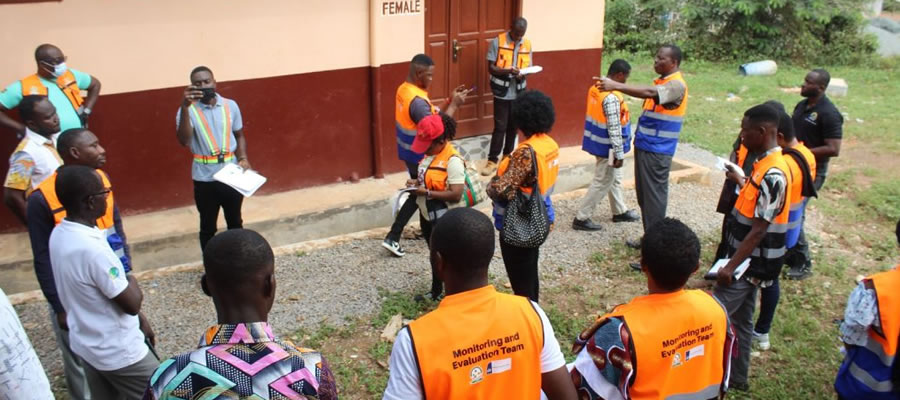

As at the end of the 2004/23005 academic year, Wassa West District had a total of 371 public basic schools comprising of 128KGS, 146 Primary and 97 Junior Secondary Schools. It also had 6 public Senior Secondary Schools, one Vocational School and full-fledged public University. There were in addition 148 private basic schools made up of 59KGS, 55 Primary schools and 34 JSS. Out of this number, 102 were registered while 46 were unregistered. The table below shows the educational programmes and their corresponding enrolment as their distribution in the 2004/2005 academic year.
Enrollment
One distinguishing feature of the school enrolment is the high concentration of pupils in urban centres. For instance, 12 selected urban/towns accounted for 47.6% of the total enrolment of the primary schools. The class size ranged between 50 and 70. In the rural areas there were over 15 schools with less than 80 pupils for the primary level. The same is true for the JSS where the 12 selected communities had 43.4% of the total enrolment, while the remaining 44 communities recorded 56.6% of the total enrolment. The skewness of enrolment towards the urban/town centres is therefore evidenced. This situation has therefore resulted in over crowdiness in the urban centre schools thereby requiring the construction of additional classrooms.
Drop-Out Rate
At the primary school level the drop-out rate was 1.1% for the District. At the Junior Secondary School level the drop-out rate was 1.4%. This level consist of adolescents whose crave for money has been kindled by the existence of ‘galamsey’ i.e. small scale illegal gold mining activities which are scattered all over the District, notably around environs of Nsuaem, Prestea, Benso, Aboso, Bogoso, Himan and Awudua.
Teacher Situation
In the 2004/2005 academic year, the District had a total of 1891 teachers in the public basic schools. These were made up of 376 teachers at the pre-school (KG), 935 teachers at the primary and 580 teachers at the Junior Secondary School. At the second cycle level, there were 178 teachers. At the KG level, 98.4% of the teachers were females with only 1.6% being males. It is however significant to note that 80.1% of the teachers were untrained.
The primary school level had 57.8% males and 42.2% females. In a similar situation, 32% of the teaching staff strength were equally untrained and such a significant number affects the quality of teaching and learning especially in the rural areas.
The male teachers constituted 74.3% with only 25.7% female staff at the JSS level as at the end of 2004/2005. In the same vein 22.1% were untrained. It therefore stands clear that the District needs to improve seriously upon the quality of the teaching staff to enhance quality of teaching and learning.
Another significant set-back is the high annual teacher attraction rates which were 6% and 5% for primary and JSS teachers respectively. There is therefore the need to introduce various interventions to attract teachers to stay longer in the District. It would be desirable if the planned annual reduction rates of 0.8% for the primary level and 0.6% could be achieved, so that the quality of teaching staff could be achieved and sustained. The Pupil Teacher Ratio (PTR) for the various levels are as shown in Table 4 below:-
Public Furniture
The pupil furniture status was 66% at all levels and the situation needs to be improved upon. The condition is even worst in the rural areas where the structures are to a large extent deplorable to deserve the supply of furniture.
Teacher’s Furniture
Teacher furniture supply situation was 68% at both the primary and JSS level but 59% at KG level. It is important that efforts are made to fill the gap of 32% as well as to cater for the additional teachers demanded within the plan period, 2006-2009. Table 7 therefore shows the status of teacher-furniture situation as at the end of 2004/2005
Pupils Toilet Facilities
The general coverage of toilet facilities (toilet/urinal) was 55%. In many schools, since the pre-school and primary levels are sited on the same premises, such facilities served the two levels. The toilet facilities are in adequate as shown on Table 8 and there would be the need to fill the gap.
Teacher Accommodation
Teacher accommodation is woefully inadequate in the District especially in the rural areas. This situation has been a single dynamic factor militating against posting of teachers to rural areas. To reduce high teacher attrition, as well as to motivate teachers to stay in the rural areas, serious efforts should be made to provide accommodation to teachers. The District Assembly and the communities could design low cost but descent teacher accommodation by adopting local and appropriate technology. The teacher-accommodation status and other tables can be found in the pdf file.
Date Created : 11/21/2017 5:21:16 AM












 facebook
facebook
 twitter
twitter
 Youtube
Youtube
 +233 593 831 280
+233 593 831 280 0800 430 430
0800 430 430 GPS: GE-231-4383
GPS: GE-231-4383 info@ghanadistricts.com
info@ghanadistricts.com Box GP1044, Accra, Ghana
Box GP1044, Accra, Ghana